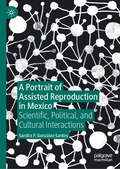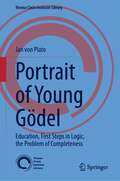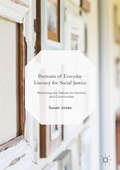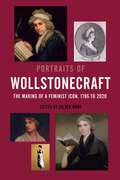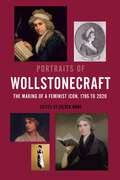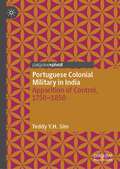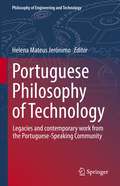- Table View
- List View
Portrait of a Moral Agent Teacher: Teaching Morally and Teaching Morality (Routledge Research in Teacher Education)
by Gillian R. RosenbergTeaching morally and teaching morality are understood as mutually dependent processes necessary for providing moral education, or the communication of messages and lessons on what is right, good and virtuous in a student’s character. This comprehensive and contextualized volume offers anecdotes and experiences on how an elementary schoolteacher envisions, enacts, and reflects on the ethical teaching and learning of her students. By employing a personally developed form of moral education that is not defined by any particular philosophical or theoretical orientation, this volume relates that classroom-based moral education can, therefore, be conceived of and promoted as moral agency. Accentuated by the teacher’s voice to offer the experience of being in the classroom, this volume enables others to transfer relevant practices to their own teaching contexts.
Portrait of a Moral Agent Teacher: Teaching Morally and Teaching Morality (Routledge Research in Teacher Education)
by Gillian R. RosenbergTeaching morally and teaching morality are understood as mutually dependent processes necessary for providing moral education, or the communication of messages and lessons on what is right, good and virtuous in a student’s character. This comprehensive and contextualized volume offers anecdotes and experiences on how an elementary schoolteacher envisions, enacts, and reflects on the ethical teaching and learning of her students. By employing a personally developed form of moral education that is not defined by any particular philosophical or theoretical orientation, this volume relates that classroom-based moral education can, therefore, be conceived of and promoted as moral agency. Accentuated by the teacher’s voice to offer the experience of being in the classroom, this volume enables others to transfer relevant practices to their own teaching contexts.
A Portrait of Assisted Reproduction in Mexico: Scientific, Political, and Cultural Interactions
by Sandra P. González-SantosThis book paints a comprehensive portrait of Mexico’s system of assisted reproduction first from a historical perspective, then from a more contemporary viewpoint. Based on a detailed analysis of books and articles published between the 1950s and 1980s, the first section tells the story of how the epistemic, normative, and material infrastructure of the assisted reproduction system was built. It traces the professionalization process of assisted reproduction as a medical field and the establishment of its professional association. Drawing on ethnographic material, the second part looks at how this system developed and flourished from the 1980s up to 2010, its commercialization process, how the expansion of reproductive services took place, and the messages regarding reproductive technologies that circulated within a wide discursive landscape. Given its scope and methods, this book will appeal to scholars interested in science and technology studies, reproduction studies, history of medicine, medical anthropology, and sociology.
A Portrait of Twenty-five Years: Boston Colloquium for the Philosophy of Science 1960–1985 (Boston Studies in the Philosophy and History of Science)
by Marx W. Wartofsky Robert S. CohenThe Boston Colloquium for the Philosophy of Science began 2S years ago as an interdisciplinary, interuniversity collaboration of friends and colleagues in philosophy, logic, the natural sciences and the social sciences, psychology, religious studies, arts and literature, and often the celebrated man-in-the street. Boston University came to be the home base. Within a few years, pro ceedings were seen to be candidates for publication, first suggested by Gerald Holton for the journal Synthese within the Synthese Library, both from the D. Reidel Publishing Company of Dordrecht, then and now in Boston and Lancaster too. Our colloquium was inheritor of the Institute for the Unity of Science, itself the American transplant of the Vienna Circle, and we were repeatedly honored by encouragement and participation of the Institute's central figure, Philipp Frank. The proceedings were selected, edited, revised in the light of the discussions at our colloquia, and then other volumes were added which were derived from other symposia, in Boston or elsewhere. A friendly autonomy, in dependent of the Synthese Library proper, existed for more than a decade and then the Boston Studies became fully separate. We were grateful to Jaakko Hintikka for his continued encouragement within that Library. The series Boston Studies in the Philosophy of Science was conceived in the broadest framework of interdisciplinary and international concerns. Natural scientists, mathematicians, social scientists and philosophers have contributed to the series, as have historians and sociologists of science, linguists, psychologists, physicians, and literary critics.
Portrait of Young Gödel: Education, First Steps in Logic, the Problem of Completeness (Vienna Circle Institute Library #9)
by Jan von PlatoIn the summer of 1928, Kurt Gödel (1906–1978) embarked on his logical journey that would bring him world fame in a mere three years. By early 1929, he had solved an outstanding problem in logic, namely the question of the completeness of the axioms and rules of quantificational logic. He then went on to extend the result to the axiom system of arithmetic but found, instead of completeness, his famous incompleteness theorem that got published in 1931. It belongs to the most iconic achievements of 20th century science and has been instrumental in the development of theories of formal languages and algorithmic computability – two essential components in the birth of the information society.This book explores Gödel’s way from an exceptional high-school student to a firmly established young logician. Essays in Gödel’s hand from the high school show that his central philosophical and scientific convictions were formed early on, before his university studies. Particular emphasis is laid on the course that made Gödel one of the foremost logicians of all times. The scientific biography of young Gödel is followed by English translations from Gödel’s German Gabelsberger shorthand of all his early preserved notebooks on logic and related topics.
Portraits and Philosophy (Routledge Research in Aesthetics)
by Hans MaesPortraits are everywhere. One finds them not only in museums and galleries, but also in newspapers and magazines, in the homes of people and in the boardrooms of companies, on stamps and coins, on millions of cell phones and computers. Despite its huge popularity, however, portraiture hasn’t received much philosophical attention. While there are countless art historical studies of portraiture, contemporary philosophy has largely remained silent on the subject. This book aims to address that lacuna. It brings together philosophers (and philosophically minded historians) with different areas of expertise to discuss this enduring and continuously fascinating genre. The chapters in this collection are ranged under five broad themes. Part I examines the general nature of portraiture and what makes it distinctive as a genre. Part II looks at some of the subgenres of portraiture, such as double portraiture, and at some special cases, such as sport card portraits and portraits of people not present. How emotions are expressed and evoked by portraits is the central focus of Part III, while Part IV explores the relation between portraiture, fiction, and depiction more generally. Finally, in Part V, some of the ethical issues surrounding portraiture are addressed. The book closes with an epilogue about portraits of philosophers. Portraits and Philosophy tangles with deep questions about the nature and effects of portraiture in ways that will substantially advance the scholarly discussion of the genre. It will be of interest to scholars and students working in philosophy of art, history of art, and the visual arts.
Portraits and Philosophy (Routledge Research in Aesthetics)
by Hans MaesPortraits are everywhere. One finds them not only in museums and galleries, but also in newspapers and magazines, in the homes of people and in the boardrooms of companies, on stamps and coins, on millions of cell phones and computers. Despite its huge popularity, however, portraiture hasn’t received much philosophical attention. While there are countless art historical studies of portraiture, contemporary philosophy has largely remained silent on the subject. This book aims to address that lacuna. It brings together philosophers (and philosophically minded historians) with different areas of expertise to discuss this enduring and continuously fascinating genre. The chapters in this collection are ranged under five broad themes. Part I examines the general nature of portraiture and what makes it distinctive as a genre. Part II looks at some of the subgenres of portraiture, such as double portraiture, and at some special cases, such as sport card portraits and portraits of people not present. How emotions are expressed and evoked by portraits is the central focus of Part III, while Part IV explores the relation between portraiture, fiction, and depiction more generally. Finally, in Part V, some of the ethical issues surrounding portraiture are addressed. The book closes with an epilogue about portraits of philosophers. Portraits and Philosophy tangles with deep questions about the nature and effects of portraiture in ways that will substantially advance the scholarly discussion of the genre. It will be of interest to scholars and students working in philosophy of art, history of art, and the visual arts.
Portraits from Memory: And Other Essays (Routledge Classics)
by Bertrand Russell‘I have come to think that one of the main causes of trouble in the world is dogmatic and fanatical belief in some doctrine for which there is no adequate evidence.’ – Bertrand Russell, Portraits from Memory Portraits from Memory is one of Bertrand Russell’s most self-reflective and engaging books. Whilst not intended as an autobiography, it is a vivid recollection of some of his celebrated contemporaries, such as George Bernard Shaw, Sidney and Beatrice Webb and D. H. Lawrence. Russell provides some arresting and sometimes amusing insights into writers with whom he corresponded. He was fascinated by Joseph Conrad, with whom he formed a strong emotional bond, writing that his Heart of Darkness was not just a story but an expression of Conrad’s ‘philosophy of life’. There are also some typically pithy Russellian observations; H. G. Wells ‘derived his importance from quantity rather than quality’, whilst after a brief and fraught friendship Russell thought D. H. Lawrence ‘had no real wish to make the world better, but only to indulge in eloquent soliloquy about how bad it was’. This engaging book also includes some of Russell’s customary razor-sharp essays on a rich array of subjects, from his ardent pacifism, liberal politics and morality to the ethics of education, the skills of good writing and how he came to philosophy as a young man. These include ‘A Plea for Clear Thinking’, ‘A Philosophy for Our Time’ and ‘How I Write’. Portraits from Memory is Russell at his best and will enthrall those new to Russell as well as those already well-acquainted with his work. This Routledge Classics edition includes a new foreword by the Russell scholar Nicholas Griffin, editor of The Selected Letters of Bertrand Russell.
Portraits from Memory: And Other Essays (Routledge Classics)
by Bertrand Russell‘I have come to think that one of the main causes of trouble in the world is dogmatic and fanatical belief in some doctrine for which there is no adequate evidence.’ – Bertrand Russell, Portraits from Memory Portraits from Memory is one of Bertrand Russell’s most self-reflective and engaging books. Whilst not intended as an autobiography, it is a vivid recollection of some of his celebrated contemporaries, such as George Bernard Shaw, Sidney and Beatrice Webb and D. H. Lawrence. Russell provides some arresting and sometimes amusing insights into writers with whom he corresponded. He was fascinated by Joseph Conrad, with whom he formed a strong emotional bond, writing that his Heart of Darkness was not just a story but an expression of Conrad’s ‘philosophy of life’. There are also some typically pithy Russellian observations; H. G. Wells ‘derived his importance from quantity rather than quality’, whilst after a brief and fraught friendship Russell thought D. H. Lawrence ‘had no real wish to make the world better, but only to indulge in eloquent soliloquy about how bad it was’. This engaging book also includes some of Russell’s customary razor-sharp essays on a rich array of subjects, from his ardent pacifism, liberal politics and morality to the ethics of education, the skills of good writing and how he came to philosophy as a young man. These include ‘A Plea for Clear Thinking’, ‘A Philosophy for Our Time’ and ‘How I Write’. Portraits from Memory is Russell at his best and will enthrall those new to Russell as well as those already well-acquainted with his work. This Routledge Classics edition includes a new foreword by the Russell scholar Nicholas Griffin, editor of The Selected Letters of Bertrand Russell.
Portraits of 21st Century Chinese Universities: In the Move to Mass Higher Education (CERC Studies in Comparative Education #30)
by Ruth Hayhoe Jun Li Jing Lin Qiang ZhaThis book examines the ways in which China’s universities have changed in the dramatic move to a mass stage which has unfolded since the late 1990s. Twelve universities in different regions of the country are portrayed through the eyes of their students, faculty and leaders.The book begins with the national level policy process around the move to mass higher education. This is followed by an analysis of the views of 2,300 students on the 12 campuses about how the changes have affected their learning experiences and civil society involvement. The 12 portraits in the next section are of three comprehensive universities, three education-related universities, three science and technology universities, and three newly emerging private universities. The final chapter sketches the contours of an emerging Chinese model of the university, and explores its connections to China’s longstanding scholarly traditions
Portraits of Everyday Literacy for Social Justice: Reframing the Debate for Families and Communities
by Susan JonesBased on an ethnographic study involving three families who live on a Midlands council housing estate, this book presents portraits of everyday lives - and the literacy practices that are part of them - as a way to explore the complex relationship between literacy and social justice. Each portrait focuses on a different aspect of literacy in everyday life: drawing on perspectives offered by the long and diverse tradition of literacy studies, each is followed by discussion of a different way of looking at literacy and what this means for social justice. The lens of literacy allows us to see the challenges faced by many families and communities as a result of social policy, and how a narrow view of literacy is often implicated within these challenges. It also illustrates the ways in which literacy practices are powerful resources in the creative and collaborative navigation of everyday lives.Arguing for the importance of looking carefully at everyday literacy in order to understand the intertwining factors that threaten justice, this book positions literary research and education as central to the struggle for wider social change. It will be of interest and value to researchers, educators and students of literacy for social justice.
Portraits of Everyday Literacy for Social Justice: Reframing the Debate for Families and Communities
by Susan JonesBased on an ethnographic study involving three families who live on a Midlands council housing estate, this book presents portraits of everyday lives - and the literacy practices that are part of them - as a way to explore the complex relationship between literacy and social justice. Each portrait focuses on a different aspect of literacy in everyday life: drawing on perspectives offered by the long and diverse tradition of literacy studies, each is followed by discussion of a different way of looking at literacy and what this means for social justice. The lens of literacy allows us to see the challenges faced by many families and communities as a result of social policy, and how a narrow view of literacy is often implicated within these challenges. It also illustrates the ways in which literacy practices are powerful resources in the creative and collaborative navigation of everyday lives.Arguing for the importance of looking carefully at everyday literacy in order to understand the intertwining factors that threaten justice, this book positions literary research and education as central to the struggle for wider social change. It will be of interest and value to researchers, educators and students of literacy for social justice.
Portraits of Influential Chinese Educators (CERC Studies in Comparative Education #17)
by Ruth HayhoeThis book conveys an understanding of China’s educational development from within and provides unique insights into Chinese society. It does so through portraits of eleven influential educators whose ideas have shaped the educational reforms initiated by Deng Xiaoping in 1978. The book makes Chinese civilization concrete through the drama of the real lives of educators and provides glimpses into the educational context of China’s recent move onto the world stage.
Portraits of Integrity: 26 Case Studies from History, Literature and Philosophy
by Charlotte Alston Amber D. Carpenter Rachael WisemanPortraits of Integrity depicts more than 20 historical, fictional and contemporary figures whose character or life raises questions about what integrity is and how it is perceived.Integrity might be culturally bound, but this diverse set of portraits demonstrates that it is not the special preserve of any one culture. Portraits of Socrates, Mencius, Rama and Job, alongside the aspirational 16th-century couple John and Dorothy Kaye, civil rights activist Ella Baker and an anonymous banker, highlight the persisting – sometimes conflicting – features of a life lived with integrity. An introduction identifies and discusses the key questions and themes raised by the case studies, encouraging the reader to determine for themselves the weight and significance of the recurring topics integrity brings up - truth, awkwardness, goodness, and charisma.For anyone looking to learn more about this elusive virtue, Portraits of Integrity is an essential collection. It uncovers the manifold aspects of integrity, illustrates the various possibilities for its expression in a life and asks whether living a life of integrity means living a life of isolation and hardship, or if it is possible to live with integrity without jeopardising all else.
Portraits of Integrity: 26 Case Studies from History, Literature and Philosophy
by Charlotte Alston Amber Carpenter Rachael WisemanPortraits of Integrity depicts more than 20 historical, fictional and contemporary figures whose character or life raises questions about what integrity is and how it is perceived.Integrity might be culturally bound, but this diverse set of portraits demonstrates that it is not the special preserve of any one culture. Portraits of Socrates, Mencius, Rama and Job, alongside the aspirational 16th-century couple John and Dorothy Kaye, civil rights activist Ella Baker and an anonymous banker, highlight the persisting – sometimes conflicting – features of a life lived with integrity. An introduction identifies and discusses the key questions and themes raised by the case studies, encouraging the reader to determine for themselves the weight and significance of the recurring topics integrity brings up - truth, awkwardness, goodness, and charisma.For anyone looking to learn more about this elusive virtue, Portraits of Integrity is an essential collection. It uncovers the manifold aspects of integrity, illustrates the various possibilities for its expression in a life and asks whether living a life of integrity means living a life of isolation and hardship, or if it is possible to live with integrity without jeopardising all else.
Portraits of Wittgenstein: Abridged Edition
by F. A. Flowers III Ian GroundPortraits of Wittgenstein is a major collection of memoirs and reflections on one of the most influential and yet elusive personalities in the history of modern philosophy, Ludwig Wittgenstein. Featuring a wealth of illuminating and profound insights into Wittgenstein's extraordinary life, this unique collection reveals Wittgenstein's character and power of personality more vividly and comprehensively than ever before. With portraits from more than 50 figures, Portraits of Wittgenstein brings together the personal recollections of philosophers, students, friends and acquaintances, including Bertrand Russell, G. E. Moore, F. R. Leavis, A. J. Ayer, Karl Popper, Friedrich von Hayek, G. H. von Wright, Freeman Dyson, Iris Murdoch, Mary Midgley and Mary Warnock. These authors testify to the life-long influence Wittgenstein had on the lives of those he met. Their fascinating memoirs, reflections and commentaries, often at odds with each other, reveal Wittgenstein's kindness, and how much genuine friendship meant to him, as well as his suffering and despair. They show too how the philosopher's ruthless honesty and uncompromising integrity often resulted in stern advice and harsh rebukes to friends and foes alike. Now abridged and available in paperback, this collection of valuable and hard-to-find material is an indispensable resource for scholars and students of the life and work of Ludwig Wittgenstein.
Portraits of Wittgenstein: Abridged Edition
by F. A. Flowers III Ian GroundPortraits of Wittgenstein is a major collection of memoirs and reflections on one of the most influential and yet elusive personalities in the history of modern philosophy, Ludwig Wittgenstein. Featuring a wealth of illuminating and profound insights into Wittgenstein's extraordinary life, this unique collection reveals Wittgenstein's character and power of personality more vividly and comprehensively than ever before. With portraits from more than 50 figures, Portraits of Wittgenstein brings together the personal recollections of philosophers, students, friends and acquaintances, including Bertrand Russell, G. E. Moore, F. R. Leavis, A. J. Ayer, Karl Popper, Friedrich von Hayek, G. H. von Wright, Freeman Dyson, Iris Murdoch, Mary Midgley and Mary Warnock. These authors testify to the life-long influence Wittgenstein had on the lives of those he met. Their fascinating memoirs, reflections and commentaries, often at odds with each other, reveal Wittgenstein's kindness, and how much genuine friendship meant to him, as well as his suffering and despair. They show too how the philosopher's ruthless honesty and uncompromising integrity often resulted in stern advice and harsh rebukes to friends and foes alike. Now abridged and available in paperback, this collection of valuable and hard-to-find material is an indispensable resource for scholars and students of the life and work of Ludwig Wittgenstein.
Portraits of Wollstonecraft: The Making of a Feminist Icon, 1785 to 2020
by Eileen M. HuntOne of The Tablet's Books of the Year 2021Portraits of Wollstonecraft collects and introduces 102 texts and artifacts that document Mary Wollstonecraft's public reception in art, literature, philosophy and feminist politics. Each portrait is a milestone in her depiction in culture. From William Blake's 1803 poem 'Mary' to Maggi Hambling's contentious sculpture in 2020, these sources validate the monumental place Wollstonecraft holds in not just one but many canons. The color images in Part I: Public Sightings trace her earliest reception in portraiture, from 1785 to 1804, with detailed analysis paired with each of the illustrations. Arranged chronologically, these landmark images are followed by the reviews of Wollstonecraft's books that appeared during her lifetime in Jamaica, Madrid, Amsterdam and London. Part II: Global Afterlives, examines her multifarious posthumous reception and features diary entries, excerpts from English-language biographies, letters, articles and introductions to her books. From Olive Schreiner's introduction to the Rights of Women composed in Cape Town in 1889 to the translator's preface to the first Czech edition of A Vindication of the Rights of Woman in 1904, they showcase an impressive sweep of cross-cultural perspectives on her life and writings. The sources in Part III: Making an International Icon chart the depth and breadth of her legacies on a global scale. Feminists, philosophers, and social scientists-from Ruth Benedict to Virginia Sapiro to Amartya Sen-have written and spoken with conviction about the emotional power of looking into the eyes of the author of the Rights of Woman. This section includes major thinkers from across the 19th and 20th centuries who responded to Wollstonecraft's theories on virtue, love, gender, education, and rights: Mary Shelley, Emma Goldman, Virginia Woolf, Simone de Beauvoir, Betty Friedan, Susan Moller Okin, Barbara Johnson and Martha Nussbaum. We see how Wollstonecraft gained traction in feminist politics, both as a philosopher and as a transcultural icon of the cause, beginning with English suffragist Millicent Fawcett's centennial edition of the Rights of Woman in 1891 and extending through feminist art in The Paris Review during the age of #MeToo. Assembling responses from Ireland, Continental Europe, North and South America and across the former colonies of the British Empire, this one-of-a-kind collection tells a compelling story of Wollstonecraft's watershed contributions to human rights debates throughout the modern and contemporary world.
Portraits of Wollstonecraft: The Making of a Feminist Icon, 1785 to 2020
One of The Tablet's Books of the Year 2021Portraits of Wollstonecraft collects and introduces 102 texts and artifacts that document Mary Wollstonecraft's public reception in art, literature, philosophy and feminist politics. Each portrait is a milestone in her depiction in culture. From William Blake's 1803 poem 'Mary' to Maggi Hambling's contentious sculpture in 2020, these sources validate the monumental place Wollstonecraft holds in not just one but many canons. The color images in Part I: Public Sightings trace her earliest reception in portraiture, from 1785 to 1804, with detailed analysis paired with each of the illustrations. Arranged chronologically, these landmark images are followed by the reviews of Wollstonecraft's books that appeared during her lifetime in Jamaica, Madrid, Amsterdam and London. Part II: Global Afterlives, examines her multifarious posthumous reception and features diary entries, excerpts from English-language biographies, letters, articles and introductions to her books. From Olive Schreiner's introduction to the Rights of Women composed in Cape Town in 1889 to the translator's preface to the first Czech edition of A Vindication of the Rights of Woman in 1904, they showcase an impressive sweep of cross-cultural perspectives on her life and writings. The sources in Part III: Making an International Icon chart the depth and breadth of her legacies on a global scale. Feminists, philosophers, and social scientists-from Ruth Benedict to Virginia Sapiro to Amartya Sen-have written and spoken with conviction about the emotional power of looking into the eyes of the author of the Rights of Woman. This section includes major thinkers from across the 19th and 20th centuries who responded to Wollstonecraft's theories on virtue, love, gender, education, and rights: Mary Shelley, Emma Goldman, Virginia Woolf, Simone de Beauvoir, Betty Friedan, Susan Moller Okin, Barbara Johnson and Martha Nussbaum. We see how Wollstonecraft gained traction in feminist politics, both as a philosopher and as a transcultural icon of the cause, beginning with English suffragist Millicent Fawcett's centennial edition of the Rights of Woman in 1891 and extending through feminist art in The Paris Review during the age of #MeToo. Assembling responses from Ireland, Continental Europe, North and South America and across the former colonies of the British Empire, this one-of-a-kind collection tells a compelling story of Wollstonecraft's watershed contributions to human rights debates throughout the modern and contemporary world.
Portraits to the Wall: Historic Lesbian Lives Unveiled (Gender Studies: Bloomsbury Academic Collections)
by Rose CollisFocusing on British and European women, this is an accessible study of lesbian history since the 17th century. Each chapter documents and examines a woman's life and work, or the nature of a particular partnership. Some of the women featured are famous, such as Greta Garbo, Ethel Smyth, Eve Balfour and Queen Anne, while others have been forgotten or undocumented. Collis's study raises many profound and seminal issues including the visibility of lesbians in different social contexts, the influence of social status and background on their ability to be open about their sexuality, the importance of sexuality to contemporary women, and the existence and creation of role models.
Portraiture and Critical Reflections on Being (Routledge Advances in Art and Visual Studies)
by Euripides AltintzoglouThis book analyzes the philosophical origins of dualism in portraiture in Western culture during the Classical period, through to contemporary modes of portraiture. Dualism – the separation of mind from body - plays a central part in portraiture, given that it supplies the fundamental framework for portraiture’s determining problem and justification: the visual construction of the subjectivity of the sitter, which is invariably accounted for as ineffable entity or spirit, that the artist magically captures. Every artist that has engaged with portraiture has had to deal with these issues and, therefore, with the question of being and identity.
Portraiture and Critical Reflections on Being (Routledge Advances in Art and Visual Studies)
by Euripides AltintzoglouThis book analyzes the philosophical origins of dualism in portraiture in Western culture during the Classical period, through to contemporary modes of portraiture. Dualism – the separation of mind from body - plays a central part in portraiture, given that it supplies the fundamental framework for portraiture’s determining problem and justification: the visual construction of the subjectivity of the sitter, which is invariably accounted for as ineffable entity or spirit, that the artist magically captures. Every artist that has engaged with portraiture has had to deal with these issues and, therefore, with the question of being and identity.
Portuguese Colonial Military in India: Apparition of Control, 1750--1850
by Teddy Y.H. SimThis book explores and analyzes developments in the military institution, military engagements as well as the larger security environment of (including non-war violence and maritime regions linking to) the Portuguese Empire in India. These developments occurred under the onslaught of the early modern globalization. The research shows that far from being dilapidated or archaic, the Portuguese colonial military there kept up with some developments in technology and organization in a competitive environment. Although the colonial military was not the most important reason in accounting for the survival of the Portuguese Estado da Índia, nor was the military profession the most lucrative occupation, the Portuguese experience gave indication of how a colonial state and society was able to survive against coalescing threats from the position of weakness. Located in the period and geographical region of the wax and waning of the Mughal and Maratha empires, Portuguese India was not necessarily a more violent place than the surrounding territories although resistance to and uprising against the Portuguese was usually underestimated. Beginning from the attempt at political and military centralization (and standardization) in the eighteenth century, the abolition of the army of the Estado da Índia in the nineteenth marked nominally the end of an era that may have a reverberation on the pacifist perception of Goa today.
Portuguese Orientalism: The Interplay of Power, Representation and Dialogue in the Nineteenth and Twentieth Centuries (The Portuguese-Speaking World)
by Marta Pinto Catarina AlmeidaResearch on Portuguese orientalism has been mostly centred on the sixteenth and seventeenth centuries and has focused on missionary work and Catholic orientalism. In contrast, reflection on the nineteenth and twentieth centuries is scarce and has relied on individual case studies, notwithstanding the TECOP (Texts and Contexts of Portuguese Orientalism: The International Congresses of Orientalists, 1873-1973) research project. This edited collection is the result of an international forum (www.tecop.letras.ulisboa.pt) hosted by the Centre for Comparative Studies, the University of Lisbon. The editorial aim is to counter the scant attention paid to Portuguese orientalist scholarship, which has been peripheralized within the comparative history of western imperialisms at large and within national orientalisms in particular. Incorporating Portugal into a broader European colonial discourse about the East, and discussing the responses to Portuguese colonial legacies, gives visibility to the agency of the multiple actors and networks implicated in the Portuguese modern connection to the East. Essays cover former Portuguese India (Goa), Macau, Timor and Japan, as well as East Africa, Egypt, and even Angola as an expansive site of the Portuguese orientalist rhetoric. The chapters by necessity revisit Edward Saids Orientalism (1978), making use of its analytical framework. They foster an understanding of Portuguese orientalism as an epistemological system supported by an elite either intellectual, scientific or literary that assumed different material manifestations in the shape of colonial policies; scientific expeditions; exhibitions; press and literary publications; radio broadcasts; and the institutionalization itself of orientalist knowledge. This is the first collection in the English language overtly expressing an intention to examine this epistemological contribution.
Portuguese Philosophy of Technology: Legacies and contemporary work from the Portuguese-Speaking Community (Philosophy of Engineering and Technology #43)
by Helena Mateus JerónimoThis volume is a collection of essays of a philosophical nature on the subject of technology, introducing authors from the Portuguese-speaking community, namely from Portugal itself, Africa and Brazil. Their contributions detail a unique perspective on technology, placing this important topic within the historical, ideological and social contexts of their countries, all of which share a common language. The shared history of these countries and the cultural and economic specificities of each one have stimulated singular insights into these thinkers’ reflections.The essays are thematically diverse. Among the topics covered are technogenic knowledge, visions of technology, risks and uncertainties, mediatization, digitalization, and datafication, engineering practice and ethics, alternative technoscientific strategies, ontotechnologies of the body, virtual and archive. The contributions also explore other themes that are more closely related to the semi-peripheral world, such as technological dependence and the incorporation of Western technology into the social structure of ancestral communities.This book appeals to students and researchers and provides a voice to authors whose work are not usually available in English-language publications. It serves as an ideal guide for all those who seek rigorous and geographically widespread knowledge regarding thinking on technology in several Portuguese-speaking countries.

